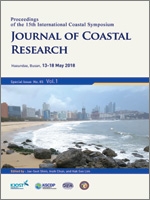Moh, T.; Cho, J.H.; Jung, S.-K.; Kim, S.-H., and Son, Y.B., 2018. Monitoring of the Changjiang River plume in the East China Sea using a wave glider. In: Shim, J.-S.; Chun, I., and Lim, H.S. (eds.), Proceedings from the International Coastal Symposium (ICS) 2018 (Busan, Republic of Korea). Journal of Coastal Research, Special Issue No. 85, pp. 26–30. Coconut Creek (Florida), ISSN 0749-0208.
Most water from the Changjiang River discharges into the East China Sea (ECS), and affects the sea's oceanographic environment, even near Jeju Island, Korea. However, most research conducted using vessels, buoys, and satellite systems has a limited capacity for continuous direct measurement over a wide area. To overcome these spatial and temporal limitations, an autonomous wave-powered glider equipped with a fluorometer, a conductivity-temperature-depth, and an acoustic Doppler current profiler was deployed. Over 34 days from August 19 to September 22 in 2016, the wave glider navigated 985 km in the ECS near Jeju Island, and sensed 34,500 continuous water columns every minute. The glider transmitted the data via the Iridium satellite communication system, even under severe weather conditions. The wave glider detected low salinity and high turbidity of the surface water southwest of Jeju Island. Comparison of the surface turbidity and back-scattered echo intensity revealed that the surface turbid water migrated from west to south of Jeju Island. It descended slightly through chaning of the mixed layer depth. The observations from this study suggest that wave gliders can provide reliable sensing and maneuvering capabilities for monitoring of the Changjiang River plume in the ECS.





